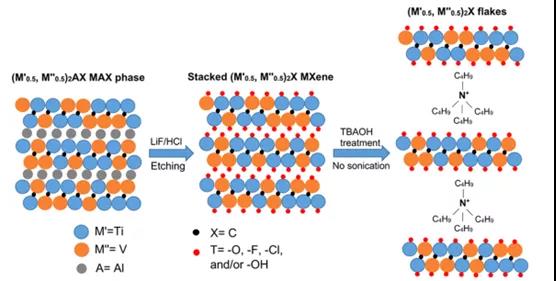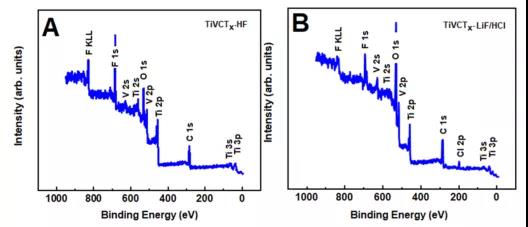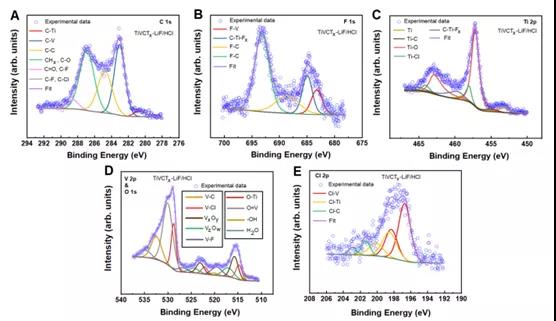
hotline:
17715390137
Tel/Wechat:
18101240246 (Technology)
0512-68565571
Email:mxenes@163.com (Sales Engineer)bkxc.bonnie@gmail.com
Scan the code to follow or search the official account on WeChat:
2D Materials Fronrier After paying attention,
click on the lower right corner to contact us,
Enter enterprise WeChat.
Professional Services Online

【Research Background】
MXenes is a new type of two-dimensional material, which has received extensive attention because of its unique physical and chemical properties. Unlike other layered materials, such as the weak van der Waals force between graphene layers, the chemical bond between NAX phases is metal Bond, ionic bond and covalent bond. Using the different bond strengths between the MAX phase layers, the weaker metal bonds of the M-A layer, especially the A atomic layer in MAX can be etched by the aqueous fluorine-containing solution to form MXenes, and the MAX 3D structure is converted into MXene 2D structure. MXenes has been widely used in many fields, of which the energy storage field is the focus of most research. The surface chemistry and functional groups of MXenes affect the electrochemical energy storage performance of MXene-based electrode materials. For example, the =O functional group can increase the energy storage capacity, and the -F and -OH functional groups will affect the immersion of electrolyte ions and reduce their energy storage capacity. The etching conditions are considered to be an important method to affect the surface chemistry of MXene. However, except for the effect of the etching conditions of Ti3C2TxMXenes on the surface functional groups, there is no other systematic study on how to control the surface functional groups during the synthesis process.
【Achievement Introduction】
Recently, Professor Sanaz Yazdanparast of Colorado School of Mines published a research paper titled: Synthesis and Surface Chemistry of 2D TiVC Solid-Solution MXenes in the internationally renowned academic journal ACS Applied Materials & Interfaces. The work used two different methods (HF and LiF/HCl) to etch TiVAlC MAX phase, synthesized TiVC solid solution MXenes, and explored its surface functional groups.
【Graphic introduction】

Figure 1. XRD images of TiVAlC MAX phase and TiVCTx MXene film obtained by LiF/HCl etching.

Figure 2. TiVC MXene synthesis process: wet etching and delamination process.

Figure 3. SEM images of TiVAlCMAX phase and TiVCTx MXene and corresponding films obtained by LiF/HCl etching.

Figure 4. Calculation of the cohesive energy and adsorption energy of different functional groups of TiVCTx MXene by DFT.

Figure 5. XPS pattern of TiVCTxMXene obtained by 50% HF and LiF/HCl etching.

Figure 6. The XPS peaks of C 1s, F 1s, Ti 2p, V 2p and O 1s of HF-etched TiVCTx MXene.

Figure 7. XPS peaks of LiV/HCl etched TiVCTx MXene C 1s, F1s, Ti 2p, V 2p, O 1s and Cl 2p.
【Summary of this article】
This paper systematically compares the effects of two etching methods on the functional groups on the surface of 2D TiVCTx solid solution MXenes. Large-scale delamination and separation can be achieved by using TBAOH to process LiF/HCl etched MXene samples at room temperature without the need for an ultrasonic step, and the TiVCTx film has a larger layer spacing, proving that water molecules and/or TBA+ are embedded in MXene floor. Based on DFT calculations, TiVC MXene with =O group functional group has the most stable structure, and compared with other functional groups, =O group functional group has stronger adhesion on the surface of MXene. EDS and XPS analysis showed that TiVCTx synthesized with mild LiF/HCl resulted in an increase in the number of =O group functional groups and a decrease in the -F group functional groups, compared to the commonly used high concentration HF etched MXene. XPS studies the surface, and the etching conditions have little effect on the concentration of -OH on the surface of TiVCMXene. The use of LiF/HCl solution has a great effect on the reduction of toxicity and cost during the synthesis of MXene, and at the same time has more favorable surface chemistry for energy storage applications.
Literature link:
https://dx.doi.org/10.1021/acsami.0c03181
Source: MXene Frontie
This information comes from the Internet for academic exchange only. If there is any infringement, please contact us to delete it immediately

| Reminder: Beijing Beike New Material Technology Co., Ltd. supplies products only for scientific research, not for humans |
| All rights reserved © 2019 beijing beike new material Technology Co., Ltd 京ICP备16054715-2号 |